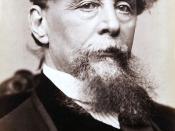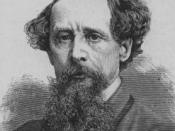In Charles Dickens', "A Tale of Two Cities", the author continually foreshadows the future revolution. Dickens depicts a Paris crowd, united by their poverty, in a frenzy to gather wine from a wine cask that was shattered. Also, we find a macabre scene in which Madame Defarge sits quietly knitting but we later discover she is knitting a list of victims slated die. Later, the theme of revenge against the nobility becomes apparent after Marquis is murdered for killing a small child with his horses. Dickens' deftly uses foreshadowing to illustrate how conflict and turmoil among the impoverished common people eventually leads to the terrible French Revolution.
In the beginning of Chapter Five of Book One, Dickens paints a vivid, yet bleak, picture of life as a commoner in France. A large wine cask is dropped in the streets and the people rush to drink it:
"...Jostling group or crowd...Some
men kneeled down, made scoops of their two hands joined, and sipped or tried to help women, who bent over their shoulders, to sip, before the wine had all run out between their fingers. Others, men and women, dipped in the puddles...with handkerchiefs from women's heads, which were squeezed dry into infant's mouths." (Dickens 36)This excerpt from "A Tale of Two Cities" demonstrates how the people were in such great poverty that they needed every bit of the spilled wine. Later, a man uses his fingers drenched in wine to right the word "BLOOD" on a wall near where the wine cask was dropped. This scene foreshadows the violence to come from furious mobs and how wild and uncontrollable a crowd can become when they are amassed for a common purpose.
Later in the novel we find Madame Defarge knitting what we later discover is a death list.


